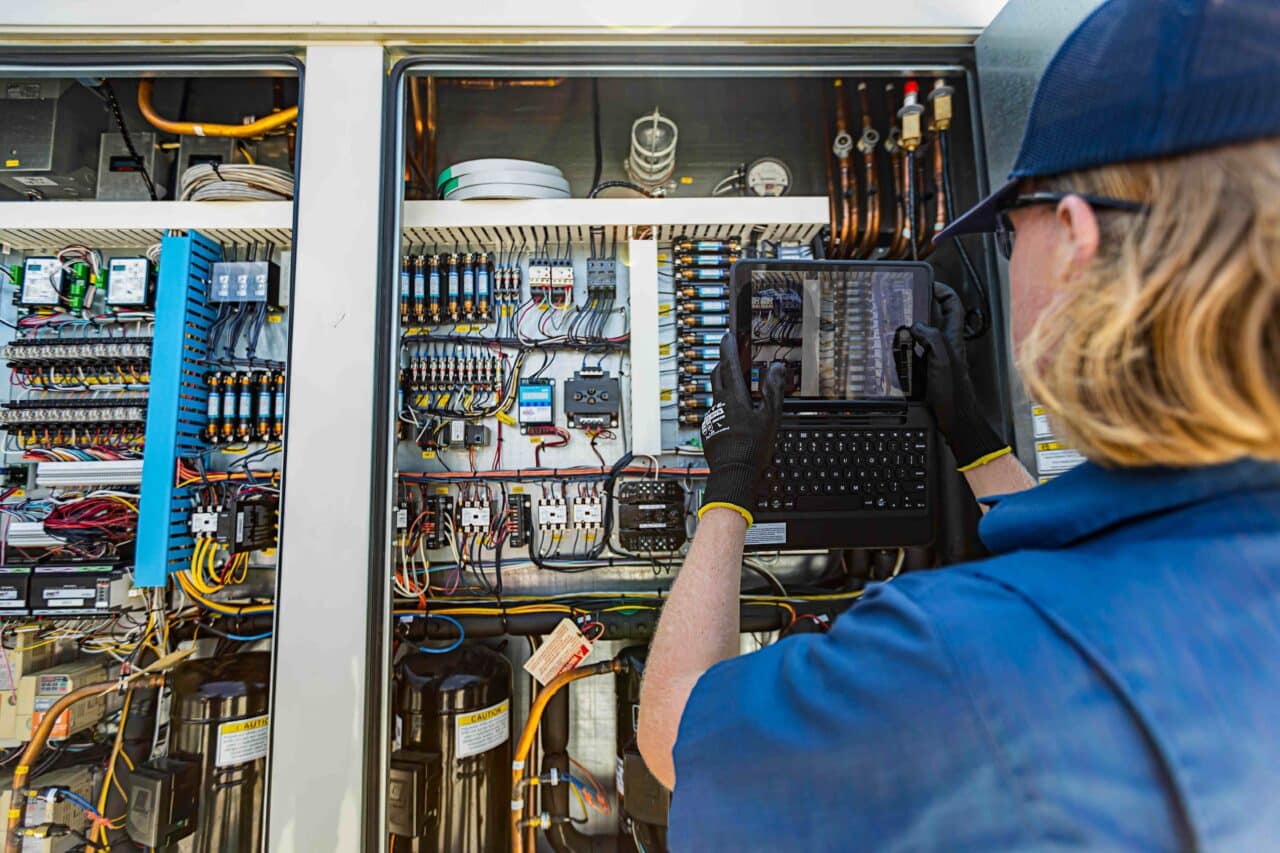How confident are you that your facility can keep up with daily operations? If your air conditioner fails on a hot day, how quickly can it be repaired? Will customers suffer in unbearable heat as you scramble for solutions? What if an electrical short causes a power outage? Will all productivity halt?
Each situation above is preventable with a robust maintenance program that ensures facility safety, energy efficiency, and compliance maintenance — all while preserving your asset’s value!
Beyond these urgent fixes, regular attention to plumbing, roofing, and fire safety systems can prevent the catastrophic consequences of neglect. Even the grounds and exterior maintenance play a crucial role in making the right first impression and ensuring safety.
Let’s explore how maintaining all aspects of your facility can turn potential operational hiccups into operational excellence!
Understanding the Role of Regular Maintenance in Facility Management
Facility maintenance is your frontline defense against the everyday wear and tear that can degrade your facility’s operations over time. It involves meticulous attention to your critical systems and various aspects of your property:
- Heating, Ventilation, and Air Conditioning (HVAC) system
- Plumbing and electrical systems
- Fire safety systems
- Structural integrity of the building
- Grounds and exterior
Proactive vs. Reactive Maintenance
With budgets and staff stretched to their limits, you may be tempted to adopt a reactive approach to maintenance. Unfortunately, this can lead to higher costs and more significant disruptions than proactive maintenance.
Here’s the difference:
- Proactive (Preventive) Maintenance: This involves scheduling maintenance activities based on a timeline or usage to avoid failures. For example, annual calibration of your building’s heating system during off-peak seasons to prevent a mid-winter breakdown.
- Reactive Maintenance: This is the “firefighting” approach where actions are taken post-breakdown, such as repairing a pipe and the subsequent water damage from an ongoing plumbing leak. But what are the costs of downtime, inconvenience, and higher emergency repair rates by waiting until systems fail?
Preventative maintenance is a small investment that reaps significant rewards by keeping your facility operational and reducing long-term costs.
Key Components of a Successful Maintenance Program
A successful maintenance program starts with a clear strategy. It should prioritize regular checks and interventions. Here’s how you can keep your facility in top condition without unnecessary complications or costs:
- Regular training for maintenance staff.
- Systematic inspections and monitoring of critical infrastructure.
- Pre-scheduled, routine upkeep tasks.
- Comprehensive documentation and record-keeping for all maintenance activities.
- Rapid response strategies for urgent maintenance needs.
Integrating technology tools such as facility management software and smart building systems can also help streamline and optimize maintenance processes. This investment can bring you even closer to your goal of operational excellence!
The Tangible Benefits of Regular Facility Maintenance
Dollars and cents matter in business. So, what’s the financial case for regular maintenance? Here are the benefits that justify the investment:
Cost Savings
Regular maintenance isn’t just an expense on your profit and loss statement. It keeps your facility in excellent condition. This mitigates the need for major repairs or replacements that can cost far more than routine check-ups.
How much could you save by avoiding the need for urgent, expensive repairs? Upkeep reports that adopting preventative maintenance strategies can lead to cost reductions of up to 18% compared to reactive approaches. And each dollar invested in preventative maintenance typically yields future savings of about $5.
Operational Efficiency
Efficient systems make for efficient operations. IndustryWeek highlights the significant financial impact of unplanned downtime, with companies shouldering an estimated $50 billion in annual costs. This downtime can devour as much as 20% of a company’s productive capacity.
Imagine your competitive edge by reducing these interruptions. Regular maintenance:
- Minimizes downtime.
- Optimizes each system.
- Maximizes productivity.
- And safeguards your operational capacity.
Safety and Compliance
Maintaining a safe and compliant facility protects your most valuable assets — your people and your property. Consider the repercussions of overlooking safety protocols. Not only are there potential fines and legal implications, but the human cost of accidents can be devastating.
Regular maintenance of HVAC, electrical, plumbing, structural elements, and grounds means these systems function correctly, minimizing risks.
2022 work injuries cost around $1,040 per worker, with medically consulted injuries averaging as much as $40,000. And OSHA penalties for violations of safety standards are now up to $16,131. Do you want to risk these costs when regular maintenance can keep your facility safe and in compliance?
Energy Efficiency and Sustainability
Energy efficiency is an essential component of facility management and cost savings. How much energy could your facility conserve with a dedicated maintenance program? Research by the Environmental Protection Agency details how proper maintenance of existing buildings can reduce overall energy consumption by up to 30%. With more aggressive strategies, this reduction can reach as much as 40%!
Asset Value Preservation
Every facility is a capital asset. Regular upkeep not only prolongs the life of this asset but also preserves its value. If you’re considering selling your facility or using it as collateral for financing, well-maintained systems and documentation of maintenance activities can significantly increase your property’s worth.
For those in the trenches of facility management, maintenance may not seem like the most exciting part of the job. However, a well-planned and executed program can deliver significant returns.
By investing in regular maintenance, you protect your operation and its assets while striving toward operational excellence.
Common Areas on a Commercial Property That Require Regular Maintenance
Every building is unique, and every facility manager has different priorities. However, certain areas consistently require regular maintenance to keep a facility running smoothly and safely.
Here’s a detailed look at the key areas, who should handle them, and specific actions for effective facility upkeep:
HVAC Systems
Regular HVAC maintenance is crucial for optimal performance and energy efficiency, preventing unexpected breakdowns, especially during peak usage. Here’s what you need to do:
- Filter Changes (Facility Manager): Replace air filters every 1-3 months, depending on the filter type, usage, and environmental factors.
- Visual Inspections (Facility Manager): Check for signs of wear and tear, such as frayed belts, corroded parts, and unusual noises.
- Energy Audit (Facility Manager or Professional): Track energy usage, identify inefficiencies, and create a plan to address them.
- Professional Servicing (Professional Required): Schedule bi-annual inspections and servicing by HVAC professionals to check refrigerant levels, clean coils, and make sure all components function correctly.
Electrical Systems
Routine checks and maintenance of electrical systems prevent shorts, outages, and potential fire hazards, ensuring a safe and reliable power supply.
- Inspection Frequency (Facility Manager): Conduct monthly visual inspections of all electrical panels, wiring, and outlets.
- Testing (Professional Required): Perform annual testing of circuit breakers, ground fault circuit interrupters (GFCIs), and surge protectors.
- Preventative Measures (Professional Required): Ensure all electrical work is compliant with National Electrical Code (NEC) standards and address any identified risks immediately.
Plumbing and Water Systems
Preventative maintenance helps avoid leaks, clogs, and water damage that disrupt your business and lead to costly repairs.
- Leak Checks (Facility Manager): Regularly inspect visible pipes and fixtures for leaks or corrosion.
- Drain Maintenance (Professional Required): Schedule quarterly professional drain cleaning to prevent clogs.
- Water Quality (Professional Required): Test water pressure and quality bi-annually to ensure safe and efficient operation of water systems.
Structural Elements
Regular inspections and maintenance of roofs, windows, and doors prevent structural deterioration and maintain the integrity of your building.
- Window and Door Checks (Facility Manager): Quarterly inspections, making sure seals are intact, and there are no drafts or water ingress.
- Roof Inspections (Facility Manager or Professional): Inspect roofs twice yearly and after severe weather for damage, leaks, and blocked gutters.
- Repairs (Professional Required): Promptly address any identified issues to avoid further damage and maintain structural integrity.
Fire Safety Systems
Fire alarms, sprinklers, and extinguishers must be in working order. This is critical for compliance and occupant safety.
- Monthly Checks (Facility Manager): Inspect fire extinguishers, ensuring they are fully charged and accessible.
- Bi-Annual Inspections (Professional Required): Test fire alarms and sprinkler systems to keep them operational.
- Compliance (Facility Manager & Professional): Keep detailed records of all maintenance activities to maintain compliance with local fire safety regulations.
Grounds and Exterior Maintenance
Well-maintained grounds and building exteriors make a positive first impression and provide safety and accessibility.
- Walkways and Parking Areas (Facility Manager): Monthly inspections for cracks, potholes, debris, and sufficient lighting to ensure safe and accessible pathways.
- Landscaping (Facility Manager or Professional): Regularly trim trees and shrubs and maintain lawn areas to avoid overgrowth.
- Exterior Cleaning (Facility Manager or Professional): Schedule periodic power washing of building exteriors, walkways, and parking areas to maintain cleanliness and curb appeal.
Developing an Effective Maintenance Program
If you don’t already have a facility maintenance program in place, or even if you do, periodically reviewing and updating it can lead to significant improvements in efficiency, cost savings, and asset value preservation.
Here are our professional recommendations to ensure they align with your facility’s needs and operational goals.
6 Steps to Build Your Maintenance Program
- Assess Facility Needs and Set Priorities: Start by thoroughly assessing your facility to identify immediate maintenance needs. Which systems are most vital to your operations? Which systems haven’t been checked in a while? Prioritize based on each system’s importance to your operations, budget constraints, and any legal requirements.
- Create a Maintenance Schedule: Develop a detailed schedule that outlines when each maintenance task should be performed. This checklist should include daily, weekly, monthly, quarterly, and annual tasks tailored to your specific facility’s needs.
- Identify Key Personnel and Responsibilities: Clearly define who is responsible for each maintenance task, whether it’s the facility manager or a professional contractor. Assigning responsibilities ensures that no tasks are overlooked or duplicated.
- Allocate Resources and Budget: Determine what each task needs, including manpower, materials, and budget. Allocate your budget to prioritize crucial tasks while allowing flexibility for unexpected repairs.
- Train Staff: Train your maintenance team on best practices (see below) and make sure they understand each task’s importance. Regular meetings and clear communication will keep everyone on the same page.
- Use Technology for Better Maintenance Management: Implement maintenance management software to streamline your processes. These tools can help schedule tasks, track progress, and store records of completed work, making you more efficient and organized.
Best Practices for Regular Maintenance
- Conduct regular inspections and audits as frequently as necessary to catch issues before they escalate.
- Keep records of all maintenance activities to understand the history of your assets, plan future replacements or upgrades, and provide evidence of compliance.
- Focus on preventive maintenance to reduce the risk of equipment failure.
- Regularly review your maintenance program and adapt to new challenges or incorporate innovative technologies as they arise.
- Partner with professional service providers for tasks that require specialized knowledge and equipment.
- Consider implementing a predictive maintenance program using sensors and data analysis to anticipate issues before they arise.
Achieving Operational Excellence with Lee Company
Does the thought of unexpected downtime or safety violations keep you up at night? When facility issues arise, they don’t just disrupt daily operations — they can also erode trust and diminish your company’s reputation. At Lee Company, we understand the stakes!
Let us take the worry out of facility management! We offer comprehensive Facilities Management and Maintenance services, including HVAC, plumbing, electrical, and more. With 8 decades of serving large and small businesses across the Southeast, we know how to prevent problems before they start. Our experienced FM2 team has the area’s largest fleet of service vehicles. Plus, we’re available 24/7 to keep your facility operating smoothly and efficiently.
Don’t let maintenance issues slow business down. Contact Lee Company today to turn your facility management into a strategic asset for operational excellence.
Invest in proactive maintenance for safety and efficiency!
CALL US NOW AT 615.567.1000

